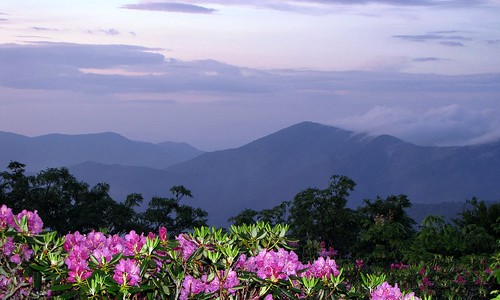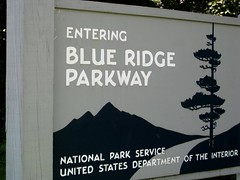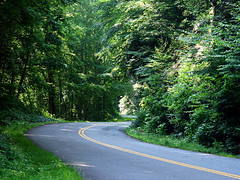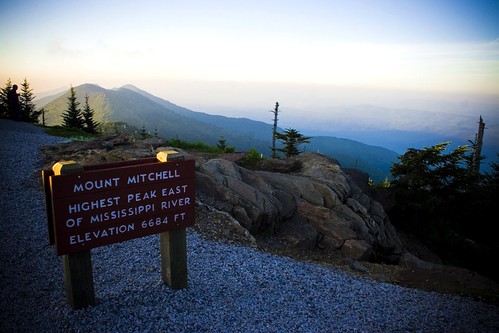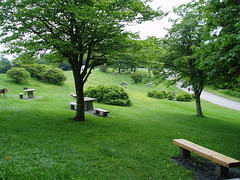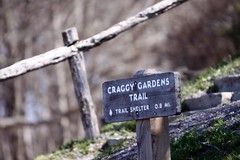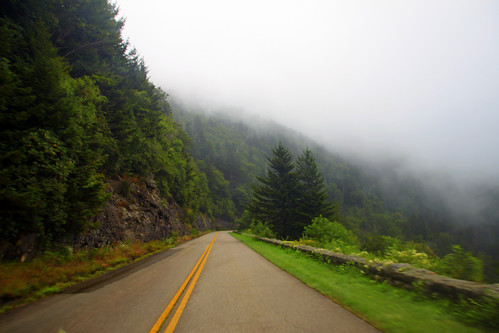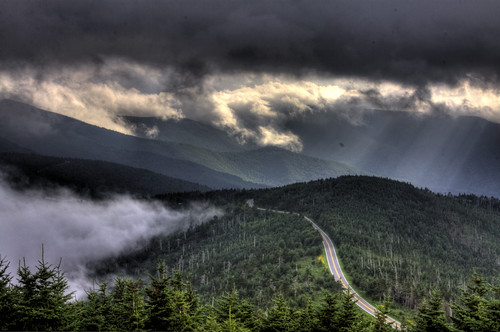The long and winding road that made me an environmentalist

Posted October 15, 2010 at 1:31PM
Today’s title is meant literally: the Blue Ridge Parkway is a 469-mile stretch of immaculately maintained scenic road that stretches southwest from Shenandoah National Park in Virginia to the Great Smoky Mountains National Park in North Carolina, plus some adjoining land and facilities along the way. Part of the US National Park System, the Parkway follows the crest of the Blue Ridge and southern Appalachians all the way, and it is not much of a stretch to say that it is largely responsible for my environmental values.
Locations along the Parkway are marked with mileposts, leading to a unique vocabulary of place. For example, I grew up in Asheville, whose main access from the Parkway is via US 70, at milepost 382. Craggy Gardens, where I went often for picnics and hikes, is at milepost 367. The turnoff to my very favorite spot in the mountains, Mount Mitchell, is at milepost 355. The scenic route to the house where my parents moved after I went off to school is Ox Creek Road, which approaches the Parkway at milepost 376. And so on.
When I was a kid, my mother and father used to keep a picnic basket packed and ready to go, so we could head up to the Parkway for dinner after their work on warm summer nights, to cool off. It was the closest thing to air conditioning that we had. I can’t tell you how many times my church’s youth group had some event or other at Craggy Gardens, also where my father first introduced me to hiking. Going to Mount Mitchell, at 6,684 feet (every kid in Asheville could tell you that number) the highest peak in eastern America, was and remains a special treat.
On and along the Parkway I learned about wildflowers (particularly mountain laurel and rhododendron), waterfalls, trees, minerals, scenic vistas, lightning, fog, tricky driving, and more than a few black bears that I have encountered up-close-and-personal. It was a good place for it, says a portion of the official web site:
“Park resources include 600 streams (150 headwaters), 47 Natural Heritage Areas (areas set aside as national, regional or state examples of exemplary natural communities), a variety of slopes and exposures, and possibly 100 different soil types. With an elevation range of 5,700 feet the Parkway provides a home for both southern species at the lower elevations and northern species on the mountaintops.
“Taking advantage of this diversity are 14 major vegetation types, about 1,600 vascular plant species
(50 threatened or endangered), and almost 100 species of non-native plants. More than 130 species of trees grow along the Parkway, about as many as are found in all of Europe. Added to that are estimates of almost 400 species of mosses and nearly 2000 species of fungi.
“Not to be outdone by the plants, many species of animals make their homes along the Parkway. Seventy-four different mammals, more than 50 salamanders and 35 reptiles can be found on Parkway lands. One hundred fifty-nine species of birds are known to nest here with dozens of others passing through during fall and spring migrations.”
I have driven its entire length two or three times, parts of it hundreds of times, stayed on multiple occasions in several of its lodges and campgrounds, hiked many of its trails (the Appalachian Trail follows roughly the same route, but usually out of sight from the road), climbed the adjacent peaks. 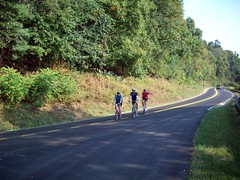 I’ve even biked a few sections, though I have avoided the major climbs, thank you very much. And, of course, in more recent years I have done all of the above also on and near the Skyline Drive, the 105-mile extension of the Parkway beginning at the southern tip of Shenandoah National Park and running the park's length to the northeast. (The Skyline Drive was built first.) Just this August, we stayed in the Peaks of Otter Lodge on the Parkway (milepost 86) and drove a hundred-mile-or-so stretch on the way to a family visit in North Carolina.
I’ve even biked a few sections, though I have avoided the major climbs, thank you very much. And, of course, in more recent years I have done all of the above also on and near the Skyline Drive, the 105-mile extension of the Parkway beginning at the southern tip of Shenandoah National Park and running the park's length to the northeast. (The Skyline Drive was built first.) Just this August, we stayed in the Peaks of Otter Lodge on the Parkway (milepost 86) and drove a hundred-mile-or-so stretch on the way to a family visit in North Carolina.
It may seem quaint in today’s environmental climate, when one of our main goals is reducing vehicle travel, for me to wax all nostalgic about a road. But it was virtually my back yard, and it’s hard to imagine having the same feelings for nature and choosing the same career path were the Parkway not such a huge part of my history and life.
This is the Parkway’s 75th anniversary year. And I was reminded of it Monday when I read a story on the National Public Radio web site, pointing out that the Parkway was built with the equivalent of stimulus money, “when stimulus funding was popular.” The National Park Service’s site for the road summarizes its history:
“Groundbreaking took place in September 1935 and the work was contracted and completed in sections. By World War II, about one-half of the road was completed and by the 1960s, all but one section was opened to the public. In 1987, the last section was completed around Grandfather Mountain in North Carolina, including the Linn Cove Viaduct at Milepost 304, an environmentally sensitive, award winning bridge.”
NPR reporter Guy Raz interviewed Anne Mitchell Whisnant, author of the book Super-Scenic Motorway: A Blue Ridge Parkway History. (You can listen to the eleven-minute radio segment here.) Whisnant says that a spirit for great public works in the 1930s kept support for the project going, but that spirit doesn't exist these days, when politicians routinely run against the government, even when the economy is strong:
"Our level of faith in the federal government [as] a doer of good for the public is nothing like it was in the '30s. So in a lot of ways, you look back and think the '30s was this moment in time when things were done that just aren't being done anymore. Not just the Parkway, but all kinds of projects that serve the public."
Today, by contrast, a certain breed of politician seems to be clamoring all over each other to oppose high-speed rail, transit tunnels and other infrastructure, when such projects could provide much-needed employment as well as substantial environmental and social benefits. In our cities, we once built great parks and squares, along with museums and libraries, with strong public assistance, support, and even pride. Sometimes those things still happen, but frequently the name of the game now is trying to find ways of funding them with private money. Otherwise, we would be committing the evil deed of, you know, daring to spend public money on the public good, an absolute no-no (unless, of course, it comes to funding reckless warfare, which is never, ever criticized as "government spending").
I am so fortunate that the current anti-government sentiment didn’t prevail when the Blue Ridge Parkway was built. It may or may not be the country’s greatest scenic road; I’ll concede that there are other contenders. But this one’s “mine.”
Thanks to Thomas Philip Davis for the link to the NPR story.
Move your cursor over the images for credit information.
